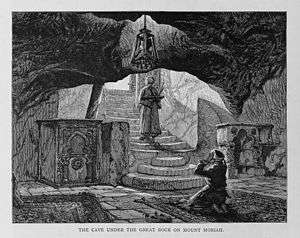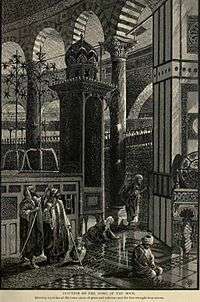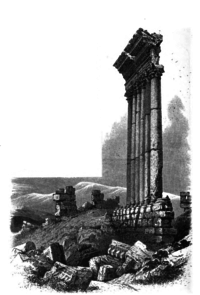Picturesque Palestine, Sinai, and Egypt
Picturesque Palestine, Sinai, and Egypt was a lavishly illustrated set of books published by D. Appleton & Co. in the early 1880s based on their phenomenally successful Picturesque America and Picturesque Europe series. It was edited by Charles William Wilson. The Appleton series was issued as "two volumes or four divisions"; it was reprinted in London by J.S. Virtue & Co., simply published as four volumes.
It was followed in 1884 by Stanley Lane-Poole's Social Life in Egypt, a kind of sequel that billed itself as "a supplement to Picturesque Palestine". It is sometimes treated as a "fifth volume" of the series,[1] but did not use Fenn or Woodward for its art.
Publication
Charles Wilson, a Royal Engineer, had attempted to improve British military intelligence in an age when spying was seen as "ungentlemanly" or "work of a low order",[2] even successfully reducing his own role in order to get a general involved who would be able to defend the interests of the intelligence service.[3] Never a spy as such, he simply "went in openly", scouting and studying areas of military interest.[3] Throughout the 19th century, the Holy Land became increasingly important as a route between Europe and the Indian Ocean: important to Britain as a faster route to India and to other powers as way around the British-held choke point at Gibraltar.[4] He had visited Jerusalem in 1864, spending ten months mapping the city with the help of local workers and even the Prussian consul.[5] He mixed research in Biblical archaeology with military and civilian intelligence about water courses and lines of defense.[5] In addition to grants from the Treasury, the detailed maps and photographs produced sold very well, earning a profit on the endeavor in their own right.[5] He then joined the Palestine Exploration Fund and directed the Survey of Western Palestine, which also acted as a "cover for military mapping".[6]
Unlike the earlier Picturesque series, Picturesque Palestine did not employ numerous artists on the project but only used two of the more successful artists from the earlier books, Harry Fenn and J.D. Woodward. Their sketches were compiled on site during Woodward and Fenn's two joint tours of Egypt and the Levant in the winters of 1877–78 and 1878–79. The two trips are documented in his correspondence with Woodward's wife and his mother. The pair received special permission to sketch inside and under the Mosque of Omar (the Dome of the Rock),[7] although Woodward compared the streets of Jerusalem with the "dirtiest alleys of Baltimore". Oppressed by the heat, glare, and barrenness, the best he could say about the shore of the Dead Sea was "I suppose it is not so bad it couldn't be worse". Nazareth was "the worst",[7] while he was most impressed by the Syrio-Roman ruins at Baalbek.[8]
The works were "enormously successful",[6] with Woodward and Fenn each earning an estimated US$10 000 a year in royalties on the Holy Land volumes.[7]
Contents
Volume I
Division I
Division I was published separately and as part of Volume I in 1881. It included an introduction by Dean Stanley and sections on "Jerusalem" by Charles William Wilson; "Bethlehem and the North of Judaea" by Canon Henry Baker Tristram; and "The Mountains of Judah and Ephraim" by Lt. Claude Reignier Conder.[9][10] It included steel engravings of Jerusalem from Scopus and from the Mount of Olives; the Dome of the Rock; Bethany; the Mount of Olives from Mount Zion; Bethlahem's Church of the Nativity; Mar Saba Monastery; the Plains of Jericho; the view from the Tomb of Samuel; and a threshing floor.[11][12]
Division II
Division II was published separately and as part of Vol. I in 1881. It included sections on "Samaria and Plain of Esdraelon" by M.E. Rogers; "Esdraelon and Nazareth" by Canon Tristram; "Galilee", "Northern Galilee", "Caesarea Philippi and the Highlands of Galilee", and "Mount Hermon and its Temples" by the American consul, Rev. Selah Merrill; "Damascus" by Philip Schaff; "Palmyra", "The Wady Barada", and "Ba'albek" by Samuel Jessup.[13][14] It included steel engravings of Nablus; Mounts Tabor, Hermon, and Lebanon; the Valley of Nazareth; Tiberias; Caesarea Philippi; Damascus's rivers and streets; and Palmyra.[15][12]
Volume II
Division III
Division III was published separately in 1881 and as part of Volume II in 1883. It included sections on "Phoenicia and Lebanon" by Henry W. Jessup; "The Phoenician Plain" by Canon Tristram; "Acre, the Key of Palestine", "Mount Carmel and the River Kishon", "Maritime Cities and the Plains of Palestine" by M.E. Rogers; "Lydda and Ramleh" and "Philistia" by Lt. Col. Warren; "The South Country of Judaea" by Canon Tristram; "The Southern Borderland and Dead Sea" by Prof. Palmer; and "Mount Hor and the Cliffs of Edom" and "The Covent of St. Catherine" by M.E. Rogers.[16][17] It included steel engravings of the Kadisha Gorge; a well at Nazareth; a map of Palestine; Beirut's St George Bay; Sidon; Haifa and Mount Carmel; Caesarea; Jaffa; Hebron; and the entrance to the Valley of Petra.[18][19]
Division IV
Division IV was published separately and as part of Vol. II in 1883. It included sections on "Sinai" by C. Pickering Clarke and on "The Land of Goshen", "Cairo", "Memphis", "Thebes", and "Edfû and Philae" by Stanley Lane-Poole.[20][21] It included steel engravings of the Sea of Galilee; a map of Egypt and Sinai; Gaza; Tyre; El Hesweh; the Valley of Inscriptions; Mount Serbal; the Valley of Jethro; the Pyramids of Giza; Luxor; the Great Temple at Karnak; and Philae.[22][19]
Supplements & translations
Social Life in Egypt was published in 1884 as "a supplement to Picturesque Palestine".[23] It included chapters on "The Townsfolk", "The Countryfolk", "School and Mosque", "The European Element",[24] and an epilogue which focused largely on the "disastrous results" of Egypt's "vicious training of women" as the primary stumbling block in the way of Egyptian prosperity.[25]
The series was translated into German as Palestine in Picture and Word (Palästina in Bild und Wort) with additional notes by the novelist and Egyptologist Georg Ebers[26] in 1884.[27] In 1882 and 1884, the artwork from Picturesque Palestine was also used for The Holy Land (French: La Terre Sainte), a popular 2-volume[28][29] abridgment of Victor Guérin's scholarly 7-volume Geographical, Historical, and Archaeological Description of Palestine.[30]
See also
-
 Media related to Picturesque Palestine, Sinai, and Egypt at Wikimedia Commons
Media related to Picturesque Palestine, Sinai, and Egypt at Wikimedia Commons - Picturesque America
- Picturesque Europe
References
Citations
- ↑ Khatib (2003), p. 206.
- ↑ Moscrop (2000), p. 55.
- 1 2 Moscrop (2000), p. 56.
- ↑ Moscrop (2000), p. 41.
- 1 2 3 Moscrop (2000), p. 57.
- 1 2 Wharton (2006), p. 202.
- 1 2 3 Ackerman (1994), p. 258.
- ↑ Ackerman (1994), p. 262.
- ↑ Pict. Pal., Div. I, pp. iii–iv.
- ↑ Pict. Pal., Vol. I, p. i.
- ↑ Pict. Pal., Div. I, p. v.
- 1 2 Pict. Pal., Vol. I, p. iii.
- ↑ Pict. Pal., Div. II, p. iv.
- ↑ Pict. Pal., Vol. I, p. i–ii.
- ↑ Pict. Pal., Div. II, p. v.
- ↑ Pict. Pal., Div. III, pp. iii–iv.
- ↑ Pict. Pal., Vol. II, pp. iii–iv.
- ↑ Pict. Pal., Div. III, p. v.
- 1 2 Pict. Pal., Vol. II, p. vi.
- ↑ Pict. Pal., Div. IV, pp. iii–iv.
- ↑ Pict. Pal., Vol. II, pp. iv–v.
- ↑ Pict. Pal., Div. IV, p. v.
- ↑ Lane-Poole (1884), p. i.
- ↑ Lane-Poole (1884), p. iii.
- ↑ Lane-Poole (1884), pp. 132 ff.
- ↑ Khatib (2003), p. 176.
- ↑ Ebers & al. (1884).
- ↑ Guérin (1882).
- ↑ Guérin (1884).
- ↑ Khatib (2003), p. 180.
Bibliography
- Picturesque Palestine, Sinai, and Egypt, Vol. I, New York: D. Appleton & Co., 1881.
- Picturesque Palestine, Sinai, and Egypt, Vol. II, New York: D. Appleton & Co., 1883.
- Picturesque Palestine, Sinai, and Egypt, Div. I, New York: D. Appleton & Co., 1881.
- Picturesque Palestine, Sinai, and Egypt, Div. II, New York: D. Appleton & Co., 1881.
- Picturesque Palestine, Sinai, and Egypt, Div. III, New York: D. Appleton & Co., 1881.
- Picturesque Palestine, Sinai, and Egypt, Div. IV, New York: D. Appleton & Co., 1883.
- Ebers, Georg; et al. (1884), Palästina in Bild und Wort. Nebst der Sinaihalbinsel und Dem Lande Gosen [Palestine in Picture and Word. Also the Sinai Peninsula and the Land of Goshen], Leipzig: Deutsche Verlags. (German)
- Guérin, Victor (1882), La Terre Sainte, Vol. I: Son Histoire, Ses Souvenirs, Ses Sites, Ses Monuments [The Holy Land: Its History, Its Records, Its Sites, Its Monuments], Paris: E. Plon & Co. (French)
- Guérin, Victor (1884), La Terre Sainte, Vol. II: Liban, Phénicie, Palestine Occidentale et Méridionale, Pétra, Sinaï, Égypte [Lebanon, Phoenicia, Western and Southern Palestine, Petra, Sinai, Egypt], Paris: E. Plon, Nourrit, & Co. (French)
- Lane-Poole, Stanley (1884), Social Life in Egypt: A Description of the Country and its People with Illustrations on Steel and Wood, London: J.S. Virtue & Co.
- Ackerman, Gerald M. (1994), "John Douglas Woodward", American Orientalists, Paris: Mame for ACR, pp. 258–265, ISBN 2-86770-078-7.
- Khatib, Hisham (2003), Palestine and Egypt under the Ottomans: Paintings, Books, Photographs, Maps, and Manuscripts, London: Tauris Parke Books, ISBN 1-86064-888-6.
- Moscrop, John James (2000), Measuring Jerusalem: The Palestine Exploration Fund and British Interests in the Holy Land, London: Cromwell Press for Leicester University Press, ISBN 0-7185-0220-5.
- Wharton, Annabel Jane (2006), Selling Jerusalem: Relics, Replicas, Theme Parks, Chicago: University of Chicago Press, ISBN 0-226-89422-3.




